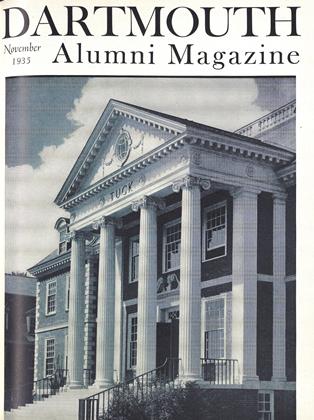, by Francis Hobart Herrick '81, Adelbert College, Cleveland, Ohio. D. Appleton-Century Company, Inc., 1935.
The author of The America?i Eagle, reviewed for this MAGAZINE last February, in his consideration of birds does not limit himself to eagles, as is clearly indicated in his latest book. Although this book contains the results of scientific study and observation in utmost detail of several species of birds, it is written in such fashion as to be most interesting to anyone who enjoys learning the ways of birds.
Mr. Herrick's special method of study, here given, deals largely with the reproductive cycle of several species, following the adults through the nest-building activities until the young are fledged. Well over one hundred illustrations give visual proof of much that is told, and his devices for securing these photographs are as ingenious as was the case in his study of the baldheaded eagle. Often nests were lifted bodily, attached to their branches, to a more suitable situation for photographs and observation, yet the birds were left to act in the same free and natural way which was theirs before the displacement.
Of the eleven chapters, the first describes his methods of study, devised by Mr. Herrick years ago, and the second gives a sample bit from the biographies of several kinds of birds. Two chapters deal in detail with the peculiar ways of the black-billed cuckoo and with the communal life of the herring gull. A chapter on nest-building in general is followed by four more detailing the close study made of the nest-building 4 process of the American robin, barn swallow, red-eyed vireo, and Baltimore oriole. Four types of nests are carefully followed from the first beginnings to completion: the mud-lined stick-and-grass affair, molded by the female as a potter turns his clay; the mud-walled cup, reinforced with grass and firmly attached to a rafter; the pensile nest attached to the fork of a branch; and the marvelous hanging basket of our most skillful weaver. These partial biographies are followed by a full statement of the many and often bizarre (to us) practices associated with the care of the Voung in the nursery, while the last chapter is a scientific and (or shall I say butt) interesting discussion from first-hand knowledge of the play of instinct in the lives of birds.
WORTHWHILE HISTORIES
Among the many fascinating matters referred to in these pages are the strange habit found in young kingfishers of walking backward, which is related to their peculiar situation in a nest at the end of a long tunnel in a sand bank; the ability of the newly fledged black-billed cuckoo to hang by one foot from a twig and its habit of leaving its nest much earlier than do similar species of birds to climb along the trunk and branches of the tree which carries their nest; and the theory, partially advanced, that the male bird is a truculent bully with a superiority complex. In fact, one could go on endlessly quoting such interesting things as these, for the book is crowded with such information, much of it new, and all very readable.
The author's discussion of the role of the male bird in singing, in guarding his territory and selecting his mate; of the part played by the two parents in building the nest; his weighing of the evidence as to the cause of social parasitism among some species of birds, notably the European cuckoo; and his personal attitude toward the play of instinct as a determining factor in birds for almost every action in their varied lives—these are well worth reading to any zoologist or to anyone who finds histories, other than human, worth-while.
 View Full Issue
View Full Issue
More From This Issue
-
 Article
ArticleTHE OUTING CLUB REORGANIZES
November 1935 By Natt W. Emerson '00 -
 Class Notes
Class NotesClass of 1914
November 1935 By Edward Leech -
 Class Notes
Class NotesClass of 1911
November 1935 By Prof. Nathaniel G. Burleigh -
 Article
ArticleHANOVER BROWSING
November 1935 By Herbert F. West '22 -
 Class Notes
Class NotesClass of 1934
November 1935 By Martin J. Dwyer Jr. -
 Class Notes
Class NotesClass of 1908
November 1935 By L. W. Griswold
Dr. Frederic P. Lord '98
Books
-
 Books
BooksHOW TO SING FOR MONEY
January 1940 By DONALD E. COBLEIGH '23 -
 Books
BooksTHE INTERWEAVING POETRY OF AMERICAN HISTORY, "NEW FRONTIERS
OCTOBER 1967 By DOROTHY BECK -
 Books
BooksGOETHE AND MUSIC.
April 1955 By FRANK G. RYDER -
 Books
BooksEXPERT BIDDING AT CONTRACT BRIDGE
July 1951 By Frederick Pierce, '01 -
 Books
BooksDOUBLE TAKE.
FEBRUARY 1972 By JOHN HURD '21 -
 Books
BooksALL THE BEST IN MEXICO
December 1974 By JOHN HURD '21




